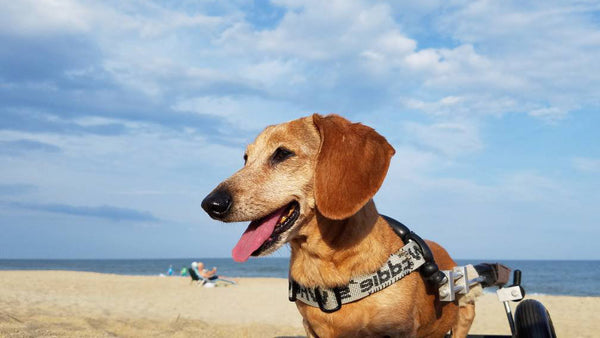Twenty-five percent of dachshunds experience an IVDD related incident during their lifetime. Wiener dog owners need to be familiar with the symptoms of IVDD and the basics treatment options that are available because response time is critical and can greatly impact the extent of recovery. Below is an overview of IVDD. For more detailed information I encourage you to check these IVDD resources.
My dachshund sister, Daisy, is in a wheelchair cart due to IVDD so it’s an issue very close to my heart. She was six when it happened and she only weight 10 lbs.
What is IVDD?
Simple definition. Intervertebral Disc Disease (IVDD) is a back problem in dogs involving the spinal cord and column that can cause pain, nerve damage and even paralysis in dachshunds and other breeds. In simple terms, IVDD disrupts messages that are sent from the brain to the body through the spinal cord about important bodily functions and actions. IVDD is also referred to as Intervertebral Disc Degeneration.
Technical terms. IVDD is when the cushion-like pads (intervertebral discs) between the bones in the spine (vertebrae) bulge or burst (herniate) into the spinal cord space putting pressure on the spinal cord, the information path between the brain and the body. The pressure hinders signals to the body causing symptoms to appear based the severity of the pressure to the spinal cord and the location of the disturbed disc.
What causes IVDD in Dogs?
Discs weaken with age or with trauma, such as hard impact actions like rough play, jumping off a sofa, etc. It can happen suddenly or over a period of time. Obese dogs have a much higher risk of developing IVDD.
- Type I. Dogs bred for short-legs, such as dachshunds, basset hounds or corgis, are susceptible to IVDD during their most active years (age 3 to 7) due to inherited skeletal deformities in their DNA. These dogs are prone to suffer from herniation of a disc, known as Hansen Type I, which is due to sudden movement or trauma.
- Type II. A gradual protrusion of a disc that occurs with age typically impacts large dog breeds (ages 8 to 10), such as German Shepherds, Labrador Retrievers, and Dobermans, is called Hansen Type II.
IVDD Prevention
Since there is no cure, only treatment, you should take preventative measures, like:
- Keeping your dachshund slim and trim will help reduce the spine and neck stress.
- Walkies with a harness instead of a collar can help keep stress off the neck
- Using ramps to get on furniture and beds
- Reducing rough play (notably tug-of-war), access to steps, jumping (especially twisting while jumping).
No steps? No jumping? I know, it's like trying to teach a dachshund not to bark – impossible, but at least try to minimize these activities. Like, try tossing stuffies low when playing fetch so your sausage dog doesn’t need to jump and twist to catch the toy. Try carrying your ween up the steps while stealing some extra snuggles and kisses.
Symptoms of IVDD
Some dachshunds will vocalize when they experience pain associated with IVDD, but some may have more subtle signs, such as:
- Tremors
- Difficulty getting up sitting or lying down
- Hunched back (tucking head and/or tail)
- Hesitancy to move their head
- Limping, walking unusually or weakness in hind legs
- Anxious behavior or reduced appetite
- Unusually quiet or withdrawn
- Loss of bladder and/or bowel control
Print this quick IVDD reference card to keep on your fridge.
IVDD Treatment Options (based on Clinical Diagnosis)
- Conservative Rest. Over 6-8 weeks crate rest paired with anti-inflammatory and pain medications. Crate rest is recommended based on a vet's clinical diagnosis and is not an appropriate option for all dogs with signs of IVDD.
- Surgery and post-operative rehabilitation.
There are a number of rehabilitation treatment options to consider in consultation with your vet, including water therapy with an underwater treadmills.
Post-op scar (that will be unnoticeable later). Pic from @WeenDixie

Disclaimer: This information provided by The Smoothe Store for basic IVDD awareness and reference. We are not veterinarians or dachshund health care professionals. None of this information should be interpreted as medical advice, please contact your vet for advice.

